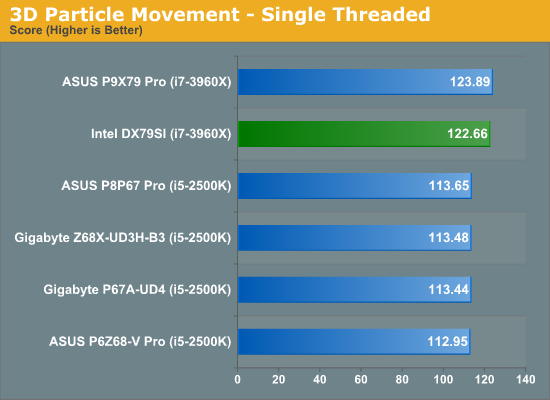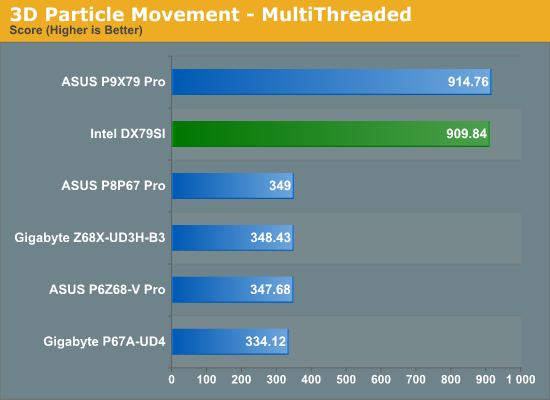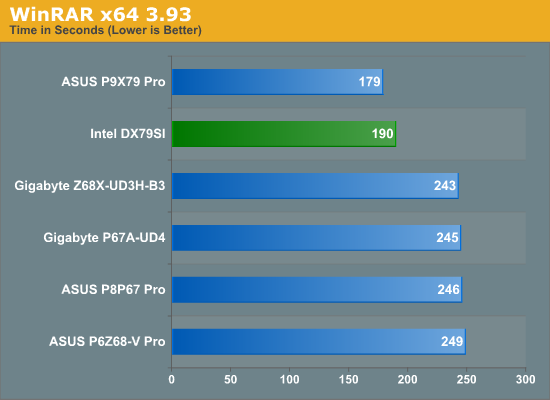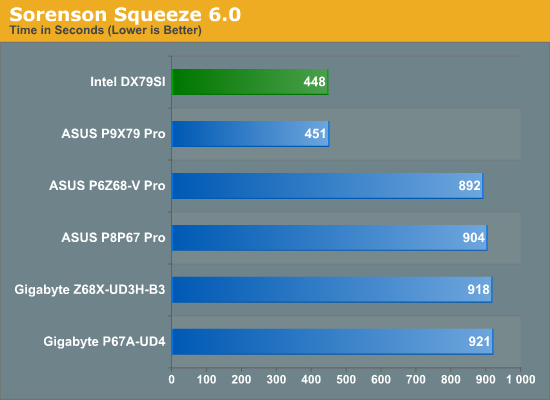Intel DX79SI Review: The Default X79?
by Ian Cutress on November 18, 2011 1:10 AM EST- Posted in
- Motherboards
- Intel
- X79
3D Movement Algorithm Test
The algorithms in 3DPM employ both uniform random number generation or normal distribution random number generation, and vary in various amounts of trigonometric operations, conditional statements, generation and rejection, fused operations, etc. The benchmark runs through six algorithms for a specified number of particles and steps, and calculates the speed of each algorithm, then sums them all for a final score. This is an example of a real world situation that a computational scientist may find themselves in, rather than a pure synthetic benchmark. The benchmark is also parallel between particles simulated, and we test the single thread performance as well as the multi-threaded performance.


As we saw with the ASUS board, the 3960X with its higher multiplier in ST and 12 threads in MT dominates our 3DPM results. However, the DX79SI does come in lower than the P9X79 Pro on both accounts.
WinRAR x64 3.93 - link
With 64-bit WinRAR, we compress the set of files used in the USB speed tests. WinRAR x64 3.93 attempts to use multithreading when possible.

Given the regularity within previous chipsets on our WinRaR test, it is perhaps surprising that the DX79SI performs a whole 11 seconds slower than the P9X79 Pro. Despite this, the results were repeatable, indicating that the boards detect differently how many CPUs are running and turbo core appropriately.
FastStone Image Viewer 4.2 - link
FastStone Image Viewer is a free piece of software I have been using for quite a few years now. It allows quick viewing of flat images, as well as resizing, changing color depth, adding simple text or simple filters. It also has a bulk image conversion tool, which we use here. The software currently operates only in single-thread mode, which should change in later versions of the software. For this test, we convert a series of 170 files, of various resolutions, dimensions and types (of a total size of 163MB), all to the .gif format of 640x480 dimensions.

As noted in previous X79 testing, FastStone seems not to benefit from the faster LGA2011 CPU, and nothing separates the X79 boards.
Sorenson Squeeze 6.0 - link
Sorenson Squeeze is a professional video encoder, complete with a vast array of options. For this test, we convert 32 HD videos, each a minute long and approximately 42 MB in size, to WMV 512KBps format. Squeeze can encode multiple videos at once, one for each thread.

As our Squeeze test uses all the threads all the time (unlike WinRar), we see a relatively small difference in the results here.










60 Comments
View All Comments
mdreed - Friday, November 18, 2011 - link
I had no idea Intel made their own mobos.mooninite - Friday, November 18, 2011 - link
*eye squint*Not sure if troll...
mygocarp - Friday, November 18, 2011 - link
I wasn't aware either.Granted, I don't really follow MBs much.
kmmatney - Friday, November 18, 2011 - link
They have pretty much been the world's biggest motherboard maker over the last 15 years or so. FoxConn used to make a lot of Intel branded motherboards in the past.Samus - Friday, November 18, 2011 - link
How can you not know Intel made their own motherboards? Even AMD at one point made a few boards to launch the K7 platform.I'm pretty sure Foxconn STILL manufactures Intel's boards, to Intel specification. All the components and connectors are usually Foxconn. You never see Amphenol and rarely see Molex-branded components. The PCB's usually have a Foxconn tag on an underside corner, indicating at least the PCB is manufactured by Foxconn.
vol7ron - Saturday, November 19, 2011 - link
He has to be a troll. What do we call comments trolls leave? Troop (troll poop, or the stuff trolls leave)?The first motherboard available for the Core2 series for months was an Intel brand, followed by ASUS and whomever else.
inighthawki - Saturday, November 19, 2011 - link
Or, maybe he's just an average tech user who browses a site like newegg and only knows of the more popular brands like ASUS, Gigabyte, etc. Intel may make a lot of boards, but that doesn't make them the most well known. Even I forgot until I read the article.vol7ron - Sunday, November 20, 2011 - link
I guess anything is possible, but I have to negate it with the probability of an average tech user leaving the first post.While it's possible he could be just some average user browsing some article on a site that he's kind of familiar with, or that he really just hadn't heard about Intel boards, since they are more known for their procs (and now SSDs); there are many readers here that subscribe to the RSS, that are generally the first to leave comments. I guess what I'm saying is that it's highly unlikely some average user would leave the first post, whereas that is generally reserved for those that keep up with the tech news. What do you think?
inighthawki - Sunday, November 20, 2011 - link
I just think you guys are being a little ridiculous that he's trolling and genuinely didn't know something. It's possible for even a more advanced tech user to have just never seen something before.Havor - Monday, November 21, 2011 - link
I have build over 500 PCs and only about 10 times have i used a Intel boards.All on request and 3 times it was for a server.
It comes from the old days, when chipsets ware big influence on performance, as all Intel mobos from ware 5~10% slower the ASUS or Abit or whomever.
But Intel never had a great name when it came to get the most out of there own chipsets!
And if you go to a e-seller, you only find Intel boards, some ware hidden away.
As there are people that prevere to have a "genuine" Intel board, from Foxconn ^_^